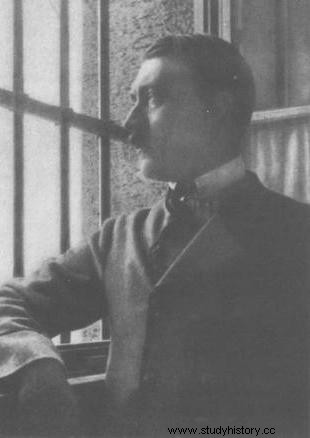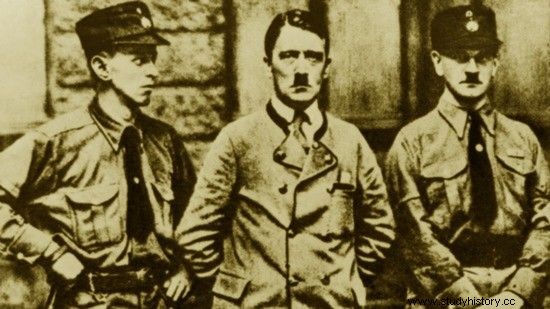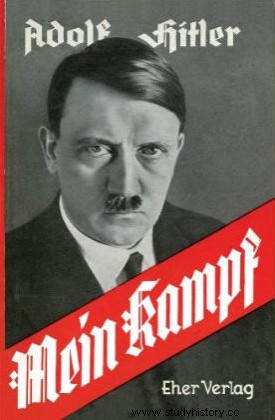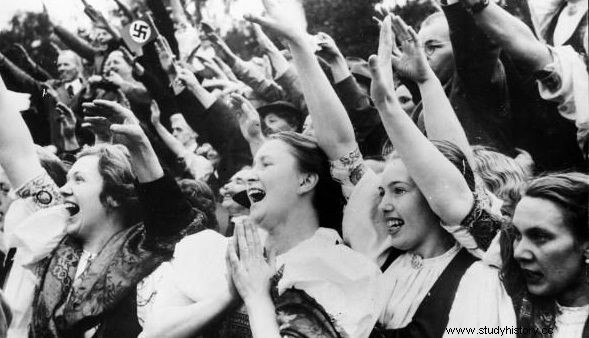This Nazi in a cassock never denied himself the pleasure of teasing Jews. He directly called for bloody pogroms. He impressed this certain inept scribble named Hitler who decided to put his mumbling rants on paper.
The gibberish was pouring out of Hitler's mouth for the second hour in a row. The future Führer had been dictating for many days one of the most sinister books that history will know - "Mein Kampf".
He was staring misguidedly at the cell window of the Landsberg prison where he was imprisoned after his failed attempt to seize power in Munich in November 1923. Every now and then he was spewing out a mixture of memories of the long months spent in the trenches and remarks about the current political situation in Europe and the treacherous Jews.
Right next to him, at a desk, was a man trying to sort out this verbal chaos and make it readable. But was more than that - the unnamed co-author of the National Socialist bible that Hitler would decide to get rid of at the appropriate moment .
A priest who hated Jews

After the failure of the failed Munich coup, Hitler ended up behind bars, where he wrote "Mein Kampf". But was he sure he was the only author?
Bernhard Stempfle began his flirtation with the extreme German right right after the Great War. In 1919 he moved to Munich - the future center of the Nazi movement. He combined his pastoral activity with aggressive political journalism.
The tone of his journalism was rather monotonous: he mainly wrote about the dire influence that Jews have over the Germans . He thundered in the newspapers about the threat that alleged Jewish atheism poses to German Catholicism.
He called for persecution and argued that in self-defense Catholics should not shy away even from bloody pogroms. Increasingly, he supported the formation of the Nazi movement.
Hitler's confidant
The virulence of his Jewish-eating attacks became the object of mockery on the part of the left-wing press. Social democratic journalists dubbed him an "anti-Semitic bishop." They described him as a fanatical Catholic Nazi who led crowds of pilgrims to the "great swastika". They mocked his hateful gutter puffery.
But there was someone who read the journalist's anti-Jewish rants carefully and seriously. Adolf Hitler, rising star of the National Socialist German Workers' Party (NSDAP).

In 1923, Bernhard Stempfle was one of Hitler's closest associates. He even became his confidant. In the photo Hitler and his protection (1923).
Both gentlemen liked each other. They had long conversations with each other on religious topics. Hitler was impressed by Stampfl's anti-Semitism, whose radicalism inspired him. The clergyman was actively involved in the Nazi movement.
In 1923, he was among Hitler's most trusted associates and became his confidant. This opened the way for the most important task he would have to undertake in his entire life so far.
How to refine the Chief's gibberish?
Hitler was not even an intellectual, much less an original thinker. His political views were a blend of racist superstition, nationalist megalomania, and primitive Darwinism. While he was undoubtedly a thrilling orator who could hypnotize a crowd, the writer was none of him. The raw material "Mein Kampf" was a veritable "peas and cabbage" - a mix of autobiographical threads and comments on various topics.
Someone from this messy pile of words had to make a book and give it style. Rudolf Hess and Stempfle were to take care of it. However, while the former was intellectually completely subordinate to Hitler, the Stempfle turned out to be strong enough to leave its own mark on the book that was being written.
This article has more than one page. Please select another one below to continue reading.Attention! You are not on the first page of the article. If you want to read from the beginning click here.

Mein Kampf - The Nazi Bible. There are many indications that the Catholic priest Bernhard Stempfle was behind its final shape.
Co-author?
Stempfel's ideological influence on Hitler is revealed, inter alia, in those fragments of "Mein Kampf", in which the role of neo-pagans in German nationalism is clearly negatively described:
Characteristic of most of these natures is that they have an excess of old Germanic heroism, that they enjoy a cloudy past, in stone axes, spears and shields, but deep down they are the greatest cowards imaginable. [...] All their activities dissuade the nation from fighting against their common enemy, the Jew.
The fanatical Catholic Stempfle could not allow the Nazi movement to be dominated by the hateful lovers of Germanic antiquities .
Hitler, though reluctant to the religion of Jesus, which he said was the worst fate ever befell humanity , succumbed to the convictions of the clergyman. He cared too much for the support of German Catholics. And although he dreamed of a Reich where Christianity would no longer matter, he needed it now.
Stempfl's role in the uprising of Mein Kampf therefore went far beyond the mere editing of Hitler's gibberish monologues. He was the co-author of the book, but it is not mentioned on the cover. And he had to pay the highest price for this co-authorship ...

Young Nazis going crazy at the sight of Hitler, like middle school fans at a Bieber concert. Without the support of a certain priest, this obsession would not have happened…
Corpse in the forest
Less than ten years later, on June 30, 1934, the body of Father Bernhard Stempfl was found in a forest near Munich. His heart was plowed with three pistol bullets and his neck was shattered . The SS executioners really wanted the clergyman to die.
He was one of the victims of the "Night of the Long Knives" - a political purge within the Nazi movement, during which Hitler got rid of some of his former party comrades. The chief made sure that no one found out that the bible of National Socialism was not only his work ...
Editor:Krzysztof Chaba; Photo edition:Rafał Kuzak
